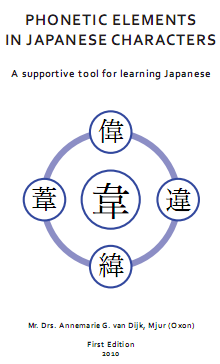My book ‘Phonetic elements in Japanese characters’ provides you with a study-aid to memorizing the Chinese (on) reading of Japanese characters. Many Japanese characters contain a sound-indicating part for the Chinese (on) reading and in my book I refer to this as the phonetic element. My book mentions 349 characters that can serve as a phonetic element for the Chinese (on) reading of a Japanese character. The phonetic elements are placed in an a, i, u, e, o order (as hiragana and katakana). For a description on hiragana and katakana, see Wikipedia link. You can view an example chapter here.
Each phonetic element has a number (the PE number). After each phonetic element you find one or more characters that have the same sound as the phonetic element. The sound is indicated in katakana. All characters can be easily found in the latest Nelson dictionary because of a reference to that effect. Quite a few Japanese characters have more than one Chinese (on) reading. It appears that sometimes two different Chinese (on) readings can be derived from the same phonetic element. In such a case I mention the phonetic element twice with a cross-reference. You can view a further description here .
There are several ways to use this study-aid. The aim is to make yourself more familiar with the sound-indicating parts in Japanese characters for the Chinese (on) reading. For example, you could identify the characters you have already memorized. In this way you will get to know which part of the character you already learned, is the sound-indicating part. That will help you when memorizing the Chinese (on) reading of new characters. Another way is to test yourself on the phonetic elements you have learned by covering up the Chinese (on) reading mentioned in my book.
You may find it interesting to know that many Japanese phonetics have their counterpart in Chinese. For those who are interested in the similarities between the Japanese and the Chinese sound-indicating parts, I included references to the dictionary written by W.E. Soothill in 1914. As said, this dictionary contains phonetics for Chinese characters.
Finally, my book does not present an exhaustive list of phonetic elements and example characters with the same sound. Please bear in mind that exceptions to the rule exist. I assume this can at least be partially explained by the fact that Japanese characters have been derived from Chinese characters used in different parts of China at different times and a language develops over time (Wikipedia Kanji).

